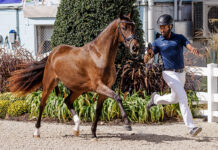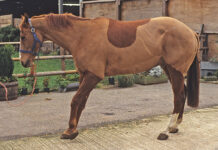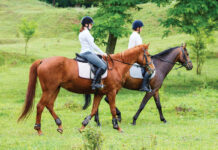
Reining trainer Sharee Schwartzenberger teaches drills to help make sure your horse knows exactly when to slow down. These drills will help you exaggerate your slow-down cue so that your horse can differentiate it from a stop or lead-change request.
Schwartzenberger says that while riders may practice circles often, the downward transition is often overlooked. Some riders overdo this maneuver, resulting in horses sliding to slow for the small circle. Sliding equals a penalty. Ideally, you’ll cue your horse for a smooth change of speeds while staying on the same circle shape you have been riding around the arena.
Schwartzenberger uses a training technique that helps your horse want to slow down. You won’t pull back on the reins as your first cue. Your horse will move freely forward into the slower gait when you don’t rely on rein aids or pull on his face.
When you’re ready to show, judges won’t see a horse who resists as he anticipates pressure from the bit. This is because you will help your horse slow down from your seat, leg and voice cues, and ensure that your horse listens to your direction without anticipating your cues.
Slow-Down Cue for the Reining Circle
When you lope a large circle, you want speed. You’ll use pressure from both legs to encourage your horse to move forward at the same time as your reining hand moves up and forward around the circle.
When you want to slow down, shift your weight to your outside hip. Keep providing pressure with your outside leg, but take your inside leg off the horse.
If you’re traveling in a circle to the left (as in the photos), keep your right leg on your horse’s side to encourage him to stay on the current lead. Apply as much calf pressure as needed to keep your horse moving forward. Removing your inside (left) leg becomes your cue to slow down.

While you’re giving this slow-down cue, hum in a long, smooth tone. If your horse doesn’t respond to the leg and voice cue and needs an extra reminder, move your reining hand up and slightly back. Your rein aids follow your leg and voice cues and help show your horse how to “bridle up” (come back to the bit) and collect.
As you start to practice, you’ll need to exaggerate your cues, Schwartzenberger says. When you are precise and consistent, your horse will learn that removing inside leg pressure means he should slow. Keep in mind that other reining cues also rely on your precise leg placement. Removing pressure with both legs equals a cue to stop; switching pressure from the outside to inside legs cues for a lead change.
Without riding in a jerky fashion, you’ll need to practice your leg positions so your horse gets the precise message.
Starting Tips
If your horse is young and just learning this cue, you may need to apply more rein pressure after giving your body cues. If your horse misses your body cue, slowly pull up and back on the reins until your horse trots, then walks. As you slow, you’ll keep forward with your hip placement (to the outside) and outside leg pressure.

As you slow your horse, Schwartzenberger says to move forward in a “C” shape as you ask for collection with the rein aids. Your horse should be arced into the direction of the circle you’re loping. Your outside leg will keep the horse arced while your reins—moving up and to the inside—guide your horse’s nose and shoulders toward the inside.
You may ride with two hands to help your horse understand your rein cues, using your outside hand to adjust speed while your inside hand shapes his body into the arc. Once your horse slows, softens and turns in toward the direction of the circle, release your aids to provide a break.
Keep in mind that you want your horse to think that slowing is a great idea. Be careful not to move harshly. Instead, relax and show your horse that your cue means that this is a chance to slow down.
Practice Fast and Slow Reining Circles Anywhere
While you’ll eventually want to show off this transition in the middle of the arena, you don’t want to practice at the middle mark every time. If you only work on a slowdown cue in the middle of the arena, your horse may choose to slow there when you don’t want him to, and some patterns may require you to continue to move fast through the middle of the circle, or you may need to switch leads in the center.
Lope your big circles and change up your slow-down location. Lope a quarter of a circle at your faster speed, then slow. Practicing the move in different locations will encourage your horse to listen to you without anticipating the slowdown.

Eventually, you will adjust your leg cues as your horse understands to slow when you remove your inside leg and hum at the same time. Horses who have practiced this transition will begin to “hunt” for this cue. They want to slow down! When your horse reads your body cues and hears your hum, he’ll slow and collect up on his own.
With practice, you’ll find that your horse’s response time quickens. Pay attention to the time it takes for your horse to slow so that you can place your slow-down cue in time for a stop at the center of the arena.
Special thanks to our equine model, Shineywhippersnapper (“Schmidty”). The 3-year-old finished in the top 15 at the National Reining Horse Non Pro Futurity.
This article about learning how to do a slow circle in the reining arena appeared in the April 2021 issue of Horse Illustrated magazine. Click here to subscribe!
Meet the TrainerTrainer and coach Sharee Schwartzenberger’s freestyle reining performances have earned her top championship titles. She coaches riders and trains reining horses in Longmont, Colo. |






